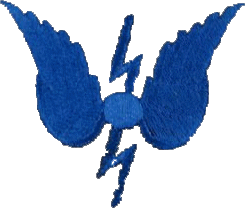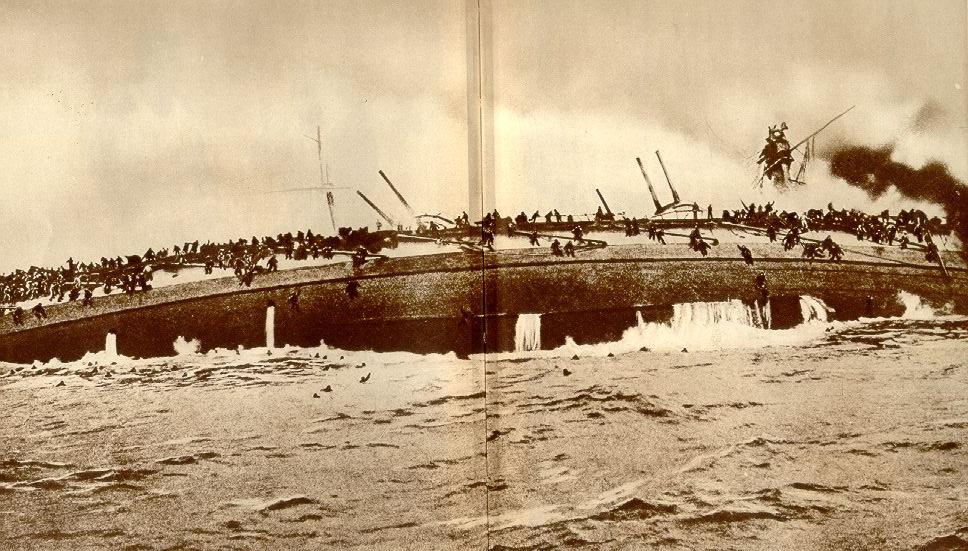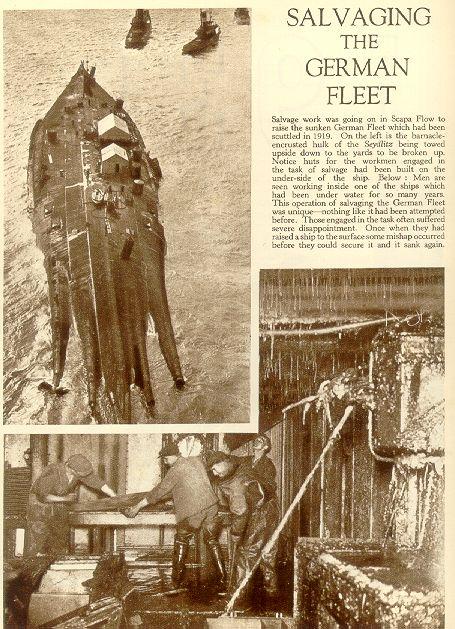|
|
|
HULL STRUCTURE |
|
The limitation of damage is a major feature of the design of the hull, achieved in the main by watertight (W.T.) subdivision.
The outer bottom while performing the duty of a watertight skin contributes largely to structural strength, it is subject to two main straining actions:-
(1) Pressure of water normal to surface
(2) Longitudinal binding action.
Plate laps and butts of plates are points of relative weakness. The inner bottom may be regarded as an inner skin the primary function of which is to maintain the watertightness of the ship in the event of the outer bottom being damaged.
The framework which stiffens the hull is built on a combination of two systems of framing.
(1) Longitudinal framing including all continuous girders running fore and aft which contribute to the longitudinal strength.
(2) Transverse framing comprises all girders which cross the longitudinal framing athwartships and afford transverse strength.
Bulkheads, besides contributing to the watertight subdivisions of the ship, fulfil two important functions.
(1) They hold the ship to form, and afford support to local loads, such as armour, decks, guns etc.
(2) Main bulkheads contribute largely to structural strength and protect important compartments against underwater explosions.
Decks contribute to structural strength and form boundaries to oiltight and watertight compartments. Deck plating is stiffened by transverse beams and by longitudinal girders. The latter are usually deeper than the beams. |
UNDERWATER SUB-DIVISION. |
|
A ship reserve of buoyancy is completely dependent upon the watertightness of the hull, and, in general, depends largely upon the extent of water tight subdivisions, which in its turn is dependent upon the type of ship and her structure. The greater the reserve buoyancy and the more complete the watertight subdivision the greater is the ships resistance to sinking.
War experience has shown that watertight integrity has been neglected, and one important lesson of the war is that, whereas, in peace, large mess decks and cabin flats come to be accepted on the score of comfort and convenience, in war they constitute a serious flooding risk.
In many ships more complete subdivisions have been achieved by the introduction of additional bulkheads, blanking of doors, hatches, ports, etc, also by the introduction of more trunks in the ship. Such spaces when between decks are made practically gastight and are provided with a natural supply and branch from a forced supply fan in addition to the fan exhaust.
Complete subdivision is compromised by the many openings which must be made in the structure, forming the boundaries of compartments, for in order that a ship may fulfil her function, allowance has to be made for:-
(1) Access to compartments, hatches, doors, etc.
(2) Passage of ships services through the compartments, fire mains, oil fuel line etc.
(3) Habitability of a compartment, ventilation, supply and exhaust trunking. |
VENTILATION. |
|
In many ships ventilation valves and trunking have seriously impaired efficient W.T., subdivision after damage has been sustained. Ventilation is an aspect of Damage Control that is largely dependent on knowledge prior to damage being received.
Basic Requirements. - A warship's requirement for fighting efficiency and protection limit the space available for efficient ventilation. The essentials of a satisfactory ventilation system are:-
(a) provision of sufficient fresh air
(b) distribution of air without causing discomfort from draughts or noises
(c) maintenance of suitable temperature and humidity
(d) reduction of wild heat
Note: Wild heat is that which is developed by running machinery or by heat leaking from a service (e.g., a steam leak at a gland) and which is not dispersed by the air convection currents set up by the ventilation systems. |
VENTILATION SYSTEMS |
|
There are two systems by which ships are ventilated.
(1) Natural Supply or Exhaust. This is the system by which air enters or leaves the compartment through trunking which is not connected to a fan, or through doors, hatches, skylights etc.
(2) Forced Ventilation. There are three methods by which forced air ventilation is provided:-
Forced supply, i.e., delivery of air from a fan which draws direct from the open. This is the only system by which positive supply of fresh air can be ensured in all circumstances. It is therefore the system by which compartments are in general ventilated. This is particularly important when the compartment is accessible through spaces containing partly vitiated air. Attempts to ventilate by fan exhaust and natural supply will then be insufficient since whenever the fan is working, and access to the compartments, and the fan will be attempting to exhaust the whole ship. In such conditions the direct natural supply will be imperative.
Exhaust System. With the forced supply the foul air is driven out to escape where it can. In certain spaces this is not suitable, and in compartments where great heat, steam disagreeable odours or deleterious gases are produced direct fan exhaust with a discharge to the open air is used. There is then no possibility of objectionable or dangerous exhaust gases being spread throughout the ship.
Spaces so ventilated include auxiliary machinery compartments, bathrooms, wash places etc, CO2 compartments etc, spaces containing petrol, paint etc.
Combination Supply and Exhaust Systems. In main engine room where great heat is developed and in a few other compartments such as medical distributing stations it is necessary to supply fresh cool air as well as to remove the foul or heated air. Both supply air exhaust fans are then fitted. The method is however wasteful of a fan power and is adapted only where absolutely necessary.
Ventilation trunking should be as direct as possible. In time they collect a film of dust inside and they should be cleaned at regular intervals, this can be done by means of brushes, awkward corners can be cleaned with a vacuum cleaner. |
TRUNKING AND VALVES |
|
Watertight slide valves are fitted in the trunking to prevent inter-compartment flooding. Bulkheads are not pierced for ventilation purposes below:
Middle deck in battleships.
Main deck on aircraft carriers.
Lower deck on cruisers.
Trunking should never be less than 5lb plating and proportionately stronger lower down in the ship. |
DAMAGE CONTROL ASPECT |
|
War experience has shown that the ventilation trunks may cause serious extensions of flooding after damage, hence it has been found necessary to reduce the ventilation system to a minimum in order to maintain watertight integrity. A careful balance must be preserved between the claims of Damage Control and Habitability. A good rule is - No ventilation which constitutes a red risk should be kept open which cannot be quickly closed.
A comparison of the rate of inflow of water through a small hole and the capacity of the ships pumps will show that the prime necessity is complete watertightness. |
KNOWLEDGE |
|
Ventilation valves and trunking have assumed a high degree of importance in relation to the spreading or otherwise of secondary flooding a much wider knowledge of systems fitted is required by ships companies generally. Every endeavour should be made to spread knowledge of these systems generally with the aid of simple explanatory diagrams. |
RECOMMENDATIONS |
|
It is essential that ship's officers should maintain continuous organised supervision and control over the arrangements fitted i.e., the manipulation of the fans, opening of valves and louvres and maintenance. This is necessary in order to ensure the best possible use is made of the systems provided. Ship's officers will be well advised to put maintenance and control on a damage control basis. Recommendation is made to use, where practical, the personnel, forming the watertight integrity patrols to operate the ventilation systems.
Portable Fans. Are used for ventilating double bottom spaces, store rooms etc. It must be borne in mind that where the ventilation system has been removed, or where none is fitted, there is a danger of accumulation of toxic and/or explosive and inflammable gases. All compartments which are shut up for periods should be ventilated before entry. In certain compartments where the ventilation system has been removed trouble is being experienced from sweating. There is the possibility where excessive sweating takes place:-
(1) Active corrosion of the structure.
(2 Stores soaking up condensed moisture. |
MAINTENANCE |
|
The watertightness of compartments can only be maintained by periodic air tests. The testing of watertight compartments is the joint responsibility of Dockyard and the ships concerned.
Non-compliance with AFO's and difficulties should not be readily accepted. See AFO 2627/46.
To slam door and drop hatches is unseamanlike for it damages the rubber and has a tendency to distort the cover and strain the hinges. Regular maintenance work on doors and hatches is essential. A summary of the more important is given in Appendix 1 to this summary.
It is necessary to "chalk test" watertight fittings periodically for watertightness. Mark all round the bearing edge with chalk, close carefully and secure the fitting by strong hand pressure (do not use Samson). The rubber should show a continuous chalk impression.
Frequent visual inspection of bulkheads and decks of W.T., compartments for holes left unblanked and for corrosion is a damage control requirement. These inspections should be included in the duties of the ventilation party which is best developed on a D.C., Section basis. Common items forming the more obvious causes of lack of watertightness are:-
(1) Obsolete single electric lead glands not blanked off.
(2) Small holes left after removal of cable tray carrying obsolete electric wiring. This is very liable to occur behind stowages and similar "out of way" places.
(3) Fittings removed and securing bracket holes not blanked.
(4) Small screws and bolts piercing W.T., structure not grometed and nutted on the other side. All holes in the W.T., structure should be tapped and gromets and washers fitted under the nuts. |
CORROSION |
|
When metals are exposed to the combined action of air and moisture corrosion ensues. This consists of oxidation of the parent metal. The detrimental effects of corrosion on ships structure is not generally appreciated. Many metals resist further corrosion because the surface layer of oxide initially formed protects the parent metal. This is not true of most ferrous alloys where the layers actually accelerates the corrosion of the metal beneath. Rusting is also aggravated by other factors among the most important are heat and acid moisture. Rust should be completely removed by chipping and wire brushing and the surface of the parent metal coated with a protective well rubbed in to seal off the surface from moisture and air. Rusting may cause loss of structural strength to a serious extent with the resultant danger to watertight integrity. |
CONTROL OF OPENINGS |
|
Basic Requirements. - Unless the maintenance of the hull structure is efficiently executed, and, unless there exists a good organisation to counteract the risk to complete W.T., subdivisions due to working of doors, etc, then the design features incorporated to limit damage may be rendered inoperative.
A ship will be most likely to survive damage if all her doors, hatches, and other openings ABOVE and BELOW the waterline are maintained in all efficient condition and are kept closed and secure.
Guiding Rule. - It should be taken as a guiding rule that every W.T., opening should be kept closed and fully secure at all times unless good reason exists for it being otherwise.
Full watertight integrity requirements - the risk accepted and the control exercises have to be balanced up with the Living, Working and Traffic requirements generally. Resolute control however, MUST be maintained over the use of doors, hatches, and valves or the safety of the ship will be seriously impaired.
WAR EXPERIENCE. - Early in the present war (17.9.39) the Board of Enquiry into the sinking of COURAGEOUS recommended that:-
"No doors through a watertight bulkhead should be open at sea unless above the waterline, allowing for a reasonable list on the ship. Deadlights on scuttles to be kept down.">br>
Shortly after, in H.F. (Home Fleet) General Order No. 34 of 21.10.39 C. in C. states:-
(1) "The loss of COURAGEOUS and ARK ROYAL has proved the danger of open hatches and doors not only those below the waterline, but also those hatches, doors and scuttles that will be below the waterline when the ship is listing or trimmed.
(2) It is essential that ships be kept watertight not only in action, but under all conditions at sea and in harbour, below the deck immediately above the waterline, or below about 8 feet above the waterline whichever is the greater.
(3) To achieve this, all watertight doors. hatches, scuttles or other openings below the datum deck should remain closed. When access to any compartment below the datum deck is essential, the hatch or door is to be opened for the minimum time and hands are to be stationed by it so that it can be closed immediately if necessary.
(4) It is realised that this will necessitate considerable alteration to sleeping and other arrangements, but it has been brought home to us most forcibly, that the above steps are necessary to ensure the safety of our ships. And some discomfort and inconvenience must be accepted".
XYZ (RED AND BLUE) SYSTEM. - To meet the above conditions and as a result of necessity a uniform system of marking W.T., Openings has been evolved for all ships consistent with operational requirements (C.A.F.O 813/43) (Confidential Admiralty Fleet Order).
In the opinion of the D.C. School it is considered preferable to have one system of Control for the two main watertight integrity requirements i.e. Ventilation and W.T., doors etc. In the new XYZ System (above) there are two aspects which require consideration:-
(1) Risk.
(2) Control
Risk. - The risk involved is shown in TWO COLOURS:-
(1) Immediate Risks - RED
(2) Less Immediate Risks - BLUE.
The line of Demarcation is the DATUM DECK. Note: The Datum Deck, normally, is the first deck which is not less than 8 feet above the Deep Water Line amidships. It is set by Admiralty and is governed by the ship's design.
As a general guide:-
(a) Openings in and below the Datum Deck are regarded as an IMMEDIATE RISK.
(b) Openings above the Datum Deck are regarded as a LESS IMMEDIATE RISK.
(c) Openings involving no risk are left UNCOLOURED.
The order "CLOSE ALL RED AND BLUE OPENINGS" will indicate that a state of emergency has arisen. The motto for the ships company will be FIRST CLOSE THE RED and THEN CLOSE THE BLUE.
Control. - From the point of view of Control , four letters X,Y,Z,O and the word ROUTINE are used. 'X' and 'Y' are normally kept CLOSED at SEA and in HARBOUR, and 'Z' openings are normally OPEN but CLOSED when the ship assumes the "Battle State". 'O' openings are only closed by SPECIAL ORDER.
Where openings conform to a definite routine, it is advisable to mark them ROUTINE instead of a lettered symbol. The routine must be displayed on or alongside the opening.
Symbols. - Certain qualifying symbols may be used. These symbols modify but DO NOT ALTER the basic 'X', 'Y' and 'Z' rules. The number used should be reduced to a minimum.
"May be left OPEN" Discs. - These may be used on certain 'Y' openings to allow more comfort in harbour when conditions permit. The issue of the discs must be rigidly controlled and kept down to a minimum as far as possible.
"Gas Alarm". - Openings that have to be closed in the event of a "Gas Alarm" are indicated by a "YELLOW CIRCLE".
Safeguards. - Requests to open 'X' openings should be kept to a minimum. It is advisable for ships orders to lay down the maximum number of 'X' openings that should be open at any one time between particular W.T., sections of a ship.
Check Systems. - Control boards are supplied in duplicate to capital ships, aircraft carriers and cruisers. The object of control boards are:-
(1) To enforce strict disciplinary control of openings.
(2) To enable the controlling centre to see at a glance the "state of ship" with reference to watertight integrity.
The method of obtaining the Watertight Door Control Board is as follows:-
(a) Drawings showing positions of all doors and hatches are usually sent to the ships officers to insert their Control requirements i.e., 'X' 'Y' and 'Z' markings. Note: Ship's officers should demand this drawing if one has not already been received.
(b) When the drawing has been completed it should be returned to the Admiralty (D.N.C. Bath) in order that the Control Boards may be prepared.
Small Ships. - No Control Board is supplied to destroyers or small ships. It is considered advisable however that ship's officers should prepare a check system. The "disc system" is recommended for small ships as being easily produced, regulated with very little trouble and can be worked with a very small personnel.
Ventilation, of compartments e.g. opening up of store rooms, must be carefully controlled and regarded as a disciplinary matter. Some ships achieve this by keeping in D.C.H.Q. a log which person concerned sign before opening such ventilation. A suitable log book is now in course of preparation for this purpose. It will be issued together with a watertight integrity statement.
Posters. - Two forms can be obtained on demand from Naval Stores:-
(a) A simplified edition of the explanation governing the regulations of XYZ (RED and BLUE) System is published as Form. S1562 (C.A.F.O's 1340/43 and 2183/45 refers)/
(b) A summary edition of XYZ (RED and BLUE) System is published on Form. S1575. This Form is designed for use of officers and higher ratings and is also intended to be of use for the instruction of men passing for higher rates (A.F.O. 3088/44 refers). |

















